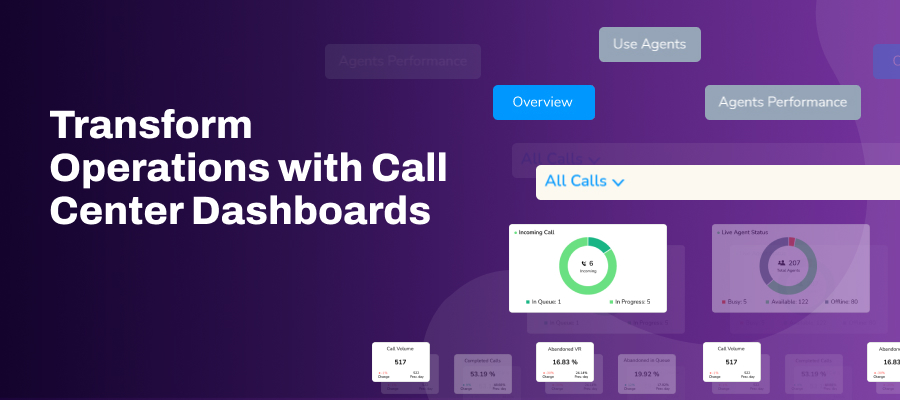Omnichannel customer experience is becoming non-negotiable, with customers expecting uninterrupted and consistent communication with companies through a blend of channels. It takes a customer-centric culture and an integrated communication to enhance customer satisfaction and drive revenue.
This blog post explores the benefits of an omnichannel strategy and the best practices for efficiently creating a cohesive customer experience.
What is Omnichannel Customer Experience?
Omnichannel customer experience unifies customer interactions across channels and touchpoints.
It helps customers to interact through one channel and continue on another. The agents can get a unified view of customer interactions from multiple channels.
Omnichannel customer experience integrates all customer information in real-time, creating a holistic view of their journey. This helps businesses improve customer satisfaction rate through better service.
Signs You Need Omnichannel Customer Experience Platform
You may be up-to-date with all the channels customers use, but how do you know if the channels are working in your favor? Here are some signs you need to look for to understand when you need an omnichannel platform:
» Channels are not in sync, and the customers are being bounced from one department to another
» Customers are complaining about the service unavailability on their preferred channels
» Customer support agents are finding it difficult to get customer information in their current system
Difference Between Omnichannel & Multi-channel Customer Experience
| Aspects | Omnichannel CX | Multi-channel CX |
| Objective | Provide a consistent experience across all channels | Allows interaction with customers via multiple channels |
| Data Consistency | Offers integrated channels with unified data | Provides independent channels leading to data silos |
| Customer Journey | Every interaction is connected regardless of the channel | Each interaction happens in isolation for that particular channel |
| Personalization | Creates adaptive, personalized, and consistent experience across all touchpoints | Creates channel-specific and inconsistent experience |
| Efficiency | Delivers faster and aligned resolution due to connected data | Delivers slower resolution due to lack of integrated data |
Benefits of Omnichannel Customer Experience
An omnichannel customer experience platform allows you to deliver relevant experience at every interaction. This creates a positive experience and boosts customer satisfaction.
This approach benefits both the business and customers in many ways.
Benefits For Businesses
Offering omnichannel customer experience can benefit your business by improving customer satisfaction, reducing agents’ workload, and getting a competitive edge. Let’s look at these benefits in detail.
» Customer journey tracking – Businesses can get a complete picture of customer journey, including past interactions, purchase history, and queries in a single view. This data can be useful to understand what customers expect and make informed business decisions.
» Improved customer experience – An omnichannel strategy gives customers a choice on how they want to interact with your company, demonstrating your attention to their preference. Moreover, they can easily switch between channels without losing continuity, resulting in a seamless customer experience.
» Increased customer retention rate – By bridging the gap between every customer interaction, you can create personalized services and integrated experience catering to targeted customer segments, making connections stronger and building trust.
» Competitive advantage – Offering an omnichannel experience differentiates your business from competitors by providing a comprehensive view of the target audience and enabling more effective marketing strategies.
Benefits For Customers
By implementing an omnichannel customer experience platform, you make your brand easily approachable to customers. This can help them:
» Easily reach out to you – With more channels at their disposal, customers and prospects can contact a brand and seek information using their preferred channel. Expanding while also unifying multiple channels differentiates a brand for its accessibility.
» Interact through their preferred channel – An omnichannel customer experience platform offers customers multiple ways to interact with a company. This increases customer convenience allowing them to connect on different channels as per their preference.
» Feel more satisfied – The omnichannel approach streamlines every piece of information across all customer interactions. This eliminates the need to repeat queries or information, reducing friction for a seamless customer experience and lower customer effort scores.
Steps to Design an Omnichannel Customer Experience
Implementing an omnichannel customer experience is effortless with proper planning and strategy. The omnichannel approach varies based on your needs and CX objectives, and there is no one-size fits all strategy.
However, here’s an overview of the process to get started:
Step 1: Analyze your Current Strategy
Before deciding to implement an omnichannel strategy, you need to analyze and evaluate your current customer experience strategy. This will allow you to understand how seamlessly you can adopt a new strategy and its scope.
For example, identify the channels you currently use to engage customers and where the omnichannel platform can increase efficiency.
Next, analyze the integration requirements of your existing system. Evaluate all your existing tools to ensure your current system seamlessly connects with the new omnichannel platform.
Finally, identify repetitive tasks that you can automate for enhanced operational efficiency.
Step 2: Map Customer Journeys
Understanding your target audience’s journeys can help you identify the key touchpoints for the omnichannel strategy.
Analyze touchpoints from first contact to post-transaction to identify pain points, find opportunities, and ensure satisfaction across channels.
Using these insights, you can adjust the customer experience strategy for each touchpoint. This can help you improve convenience and personalize customer engagement.
Step 3: Choose & Implement an Omnichannel Platform
This is the most important step — choosing an omnichannel customer experience software. There are plenty of solutions available in the market, but you can choose one that meets your business needs.
For example, Ameyo by Exotel is a cloud-based contact center solution that helps you deliver consistent customer experience across channels.
Its scalable and customizable platform offers features like contact center analytics and reporting, CRM integration, and routing. It ensures a seamless communication infrastructure that’s suitable for almost all industries.
Step 4: Collect Feedback & Improve Regularly
This is a continuous process, as you need to train agents, monitor performance and modify your omnichannel strategy to stay relevant.
You can monitor key performance indicators like customer satisfaction and retention rates to evaluate the effectiveness of your strategy.
Additionally, conduct a routine evaluation of your omnichannel setup to identify inconsistencies and bottlenecks. Implement feedback loops within the team to swiftly address issues and ensure your strategy remains responsive to evolving customer expectations.
Best Practices for Delivering a Seamless Customer Experience
The way to deliver the best omnichannel customer experience is to improve it over time. Here are some best practices you can implement:
» Evaluate Customer Satisfaction
Listen to the customer’s voice to understand how successfully you have understood their needs. Send out surveys periodically or after major changes to gain insight into customer satisfaction.
» Optimize Mobile Capabilities
Optimize your strategy for mobile channels like SMS and messenger apps to target a diverse audience and help them contact you conveniently.
» Maintain Consistent Communication
Identify communication discrepancies across channels to ensure consistent messaging, tone, and style. This will help reinforce branding and align every interaction with the brand’s voice across multiple platforms.
» Deliver Proactive Services
An omnichannel view and a dedicated team empower you to deliver proactive service. An integrated platform ensures that agents receive customer queries in a timely manner and swiftly respond. Moreover, insights into the customer journey enable you to provide communications and services at the right time.
Real-World Examples of Omnichannel Customer Experience
Let’s explore how popular brands have implemented omnichannel strategies to create convenient customer journeys.
IKEA
The leading furniture retailer company has been innovative in their omnichannel strategy. They have a “Click and Collect” model for their products, using which the customers can customize and order products online to pick it up from the nearest store.
It offers CX through channels like web, mobile apps, and SMS notifications. For example, the customer can place the order via web or mobile app, get notified through SMS when it’s ready, and can collect it from their local store.
Apple
Apple is a great example of a seamless and connected physical and digital customer experience. The brand innovates the retail space with its online services that go beyond simple pick-up online orders in their store.
The Genius Bar service enables customers to make appointments for repairs and additional support, as well as receive support from an expert via phone, email, or chat.
Sephora
Sephora, the leading cosmetic retailer, has mastered omnichannel experience across the website and in-store. From allowing customers to buy online and pick up in-store to providing a “Virtual Artist” program, Sephora innovates an interactive customer experience.
The brand has built its omnichannel experience with intuitive website architecture and mobile apps. For example, the website offers recommendations and daily picks based on customer’s purchases and browsing history for an engaging beauty experience.
Omnichannel Customer Experience: Key Takeaways
Omnichannel platforms like Exotel help you seamlessly deliver continuous, personalized customer experiences across channels. The cloud-based platform offers a scalable and efficient solution that comes with:
» Seamless connection between the communication channels
» No-hassle integration with other popular tools like chat, CRMs, and telecommunications
» A unified dashboard to access real-time communications data across channels
» Workflow automation features to reduce repetitive tasks
Book a demo today to learn more about how Exotel can help you achieve omnichannel excellence.
FAQs
What are the Key Components of an Omnichannel Strategy?
The key components of an omnichannel strategy includes customer data integration, data transition between channels, consistent messaging, and personalized experience.
What are the 4 C’s of Omnichannel?
The 4C’s of omnichannel are consistency, continuity, convenience, and customization. These principles design a seamless customer journey, enhancing satisfaction and loyalty.
 +91-808 8919 888
+91-808 8919 888 +91-808 8919 888
+91-808 8919 888 +966 135 181 912
+966 135 181 912




